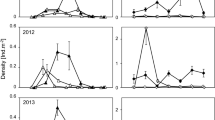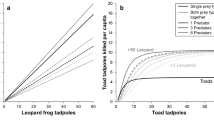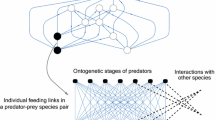Abstract
Individuals of different sizes in size-structured populations often differ greatly in the use of resources and/or space. Spectacular examples include shifts, within a lifetime, from carnivory to herbivory (e.g., some turtles; Clark and Gibbons 1969), or from herbivory to carnivory (e.g., some copepods; Neill and Peacock 1980), or from aquatic to terrestrial habitats (e.g., many amphibians). Many other species show large shifts in prey size or habitat use as they grow, but yet other species show little difference across sizes (Fraser 1976; Polis 1984; Werner and Gilliam 1984; Persson this Vol.). Thus, patterns of resource and habitat use within a species vary from complete segregation between two given size classes, to partial overlap, to complete overlap. The presence or absence of such diet or habitat segregation between different size classes can greatly affect population structure and dynamics. For example, the degree of overlap between different size classes influences population stability, and the intensity of competition between classes influences, in interesting ways, whether increases in the density of a given class increases or decreases the density of other classes (Tschumy 1982; Mittelbach and Chesson 1987; Ebenman this Vol.).
Access this chapter
Tax calculation will be finalised at checkout
Purchases are for personal use only
Preview
Unable to display preview. Download preview PDF.
Similar content being viewed by others
References
Abrahams MV, Dill LM (1989) A determination of the energetic equivalence of the risk of predation. Ecology (in press).
Abrams P (1984) Foraging time optimization and interactions in food webs. Am Nat 124:80–96.
Breden F, Stoner G (1987) Male predation risk determines female preference in the Trinidad guppy. Nature (London) 329:831–833.
Clark DB, Gibbons JW (1969) Dietary shift in the turtle Pseudemys scripta (Schoepff) from youth to maturity. Copeia 1969:704–706.
Dill LM (1987) Animal decision making and its ecological consequences: the future of aquatic ecology and behaviour. Can J Zool 65:803–811.
Endler J (1980) Natural selection on color patterns in Poecilia reticulata. Evolution 34:76–91.
Fagan R (1987) A generalized habitat matching rule. Evol Ecol 1:5–10.
Fraser DF (1976) Coexistence of salamanders in the genus Plethodon: variation of the Santa Rosalia theme. Ecology 57:238–251.
Fraser DF, Gilliam JF (1987) Feeding under predation hazard: response of the guppy and Hart’s rivulus from sites with contrasting predation hazard. Behav Ecol Sociobiol 21:203–209.
Gilliam JF, Fraser DF (1987) Habitat selection under predation hazard: test of a model with foraging minnows. Ecology 68:1856–1862.
Gilliam JF, Fraser DF, Sabat AM (1989) Strong effects of foraging minnows on a stream benthic invertebrate community. Ecology (in press).
Haskins CP, Haskins EF, McLaughlin JJA, Hewitt RE (1961) Polymorphism and population structure in Lebistes reticulata, a population study. In: Blair WD (ed) Vertebrate speciation. Univ Texas Press, Austin, pp 320–395.
Helfman GS (1986) Behavioral responses of prey fishes during predator-prey interactions. In: Feder ME, Lauder GV (eds) Predator-prey relationships: perspectives and approaches from the study of lower vertebrates. Univ Press, Chicago, III, pp 135–156.
Houde AE (1988) Genetic differences in female choice between two guppy populations. Anim Behav (in press).
Ives AR, Dobson AP (1987) Antipredator behavior and the population dynamics of simple predatorprey systems. Am Nat 130:431–447.
Iwasa Y (1982) Vertical migration of Zooplankton: a game between predators and prey. Am Nat 120:171–180.
Kneib RT (1987) Predation risk and use of intertidal habitats by young fishes and shrimp. Ecology 68:379–386.
Liley NR, Seghers BH (1975) Factors affecting the morphology and behavior of guppies in Trinidad. In: Baerends GP, Beer C, Manning A (eds) Function and evolution in behaviour. Oxford Univ Press, pp 92-118.
Milinski M (1986) Constraints placed by predators on feeding behaviour. In: Pitcher TJ (ed) The behaviour of teleost fishes. Croom Helm, London, pp 236–252.
Mittelbach GG, Chesson PL (1987) Predation risk: indirect effects on fish populations. In: Kerfoot WC, Sih A (eds) Predation: direct and indirect impacts on aquatic communities. Univ New Engl, Hanover, NH, pp 315–332.
Neill WE, Peacock A (1980) Breaking the bottleneck: interactions of invertebrate predators and nutrients in oligotrophic lakes. In: Kerfoot WC (ed) Evolution and ecology of Zooplankton communities. Univ Press New Engl, Hanover, NH, pp 715–724.
Parker GA, Sutherland WJ (1986) Ideal free distributions when individuals differ in competitive ability: phenotype-limited ideal free models. Anim Behav 34:1222–1242.
Polis GA (1981) The evolution and dynamics of intraspecific predation. Annu Rev Ecol Syst 12:225–251.
Polis GA (1984) Age structure component of niche width and intraspecific resource partitioning: can age groups function as ecological species? Am Nat 123:541–564.
Polis GA, McCormick SJ (1987) Intraguild predation and competition among desert scorpions. Ecology 68:332–343.
Power ME (1987) Predator avoidance by grazing fishes in temperate streams: importance of stream depth and prey size. In: Kerfoot WC, Sih A (eds) Predation: direct and indirect impacts on aquatic communities. Univ Press New Engl, Hanover, NH, pp 333–351.
Power ME, Matthews WJ, Stewart AJ (1985) Grazing minnows, piscivorous bass, and stream algae: dynamics of a strong interaction. Ecology 66:1448–1456.
Reznick DN (1982) Genetic determination of offspring size in the guppy (Poecilia reticulata). Am Nat 120:181–188.
Rosenzweig ML (1981) A theory of habitat selection. Ecology 62:327–335.
Schlosser IJ (1987) The role of predation in age-and size-related habitat use by stream fishes. Ecology 68:651–659.
Sih A (1980) Optimal behavior: can foragers balance two conflicting demands? Science 210:1041–1043.
Sih A (1987) Predator and prey lifestyles: an evolutionary and ecological overview. In: Kerfoot WC, Sih A (eds) Predation: direct and indirect impacts on aquatic communities. Univ Press New Engl, Hanover, NH, pp 203–224.
Sih A (1987) Prey refuges and predator-prey stability. Theor Popul Biol 31:1–12.
Stamps JA (1983) The relationship between ontogenetic habitat shifts, competition and predator avoidance in a juvenile lizard (Anolis aeneus). Behav Ecol Sociobiol 12:19–33.
Stephens DW, Krebs JR (1986) Foraging theory. Univ Press, Princeton, NJ.
Sutherland WJ, Parker GA (1985) Distribution of unequal predators. In: Sibly RM and Smith RH (eds) Behavioural ecology. Blackwell, London, pp 255–274.
Tschumy WO (1982) Competition between juveniles and adults in age-structured populations. Theor Popul Biol 21:255–268.
Werner EE, Gilliam JF (1984) The ontogenetic niche and species interactions in size-structured populations. Annu Rev Ecol Syst 15:393–425.
Werner EE, Hall DJ (1988) Ontogenetic habitat shifts in the bluegill sunfish (Lepomis macrochirus): the foraging rate-predation risk tradeoff. Ecology (in press).
Werner EE, Gilliam JF, Hall DJ, Mittelbach GG (1983a) An experimental test of the effects of predation risk on habitat use in fish. Ecology 64:1540–1548.
Werner EE, Mittelbach GG, Hall DJ, Gilliam JF (1983b) Experimental tests of optimal habitat use in fish: the role of relative habitat profitability. Ecology 64:1540–1548.
Author information
Authors and Affiliations
Editor information
Editors and Affiliations
Rights and permissions
Copyright information
© 1988 Springer-Verlag Berlin Heidelberg
About this paper
Cite this paper
Gilliam, J.F., Fraser, D.F. (1988). Resource Depletion and Habitat Segregation by Competitors Under Predation Hazard. In: Ebenman, B., Persson, L. (eds) Size-Structured Populations. Springer, Berlin, Heidelberg. https://doi.org/10.1007/978-3-642-74001-5_12
Download citation
DOI: https://doi.org/10.1007/978-3-642-74001-5_12
Publisher Name: Springer, Berlin, Heidelberg
Print ISBN: 978-3-642-74003-9
Online ISBN: 978-3-642-74001-5
eBook Packages: Springer Book Archive




